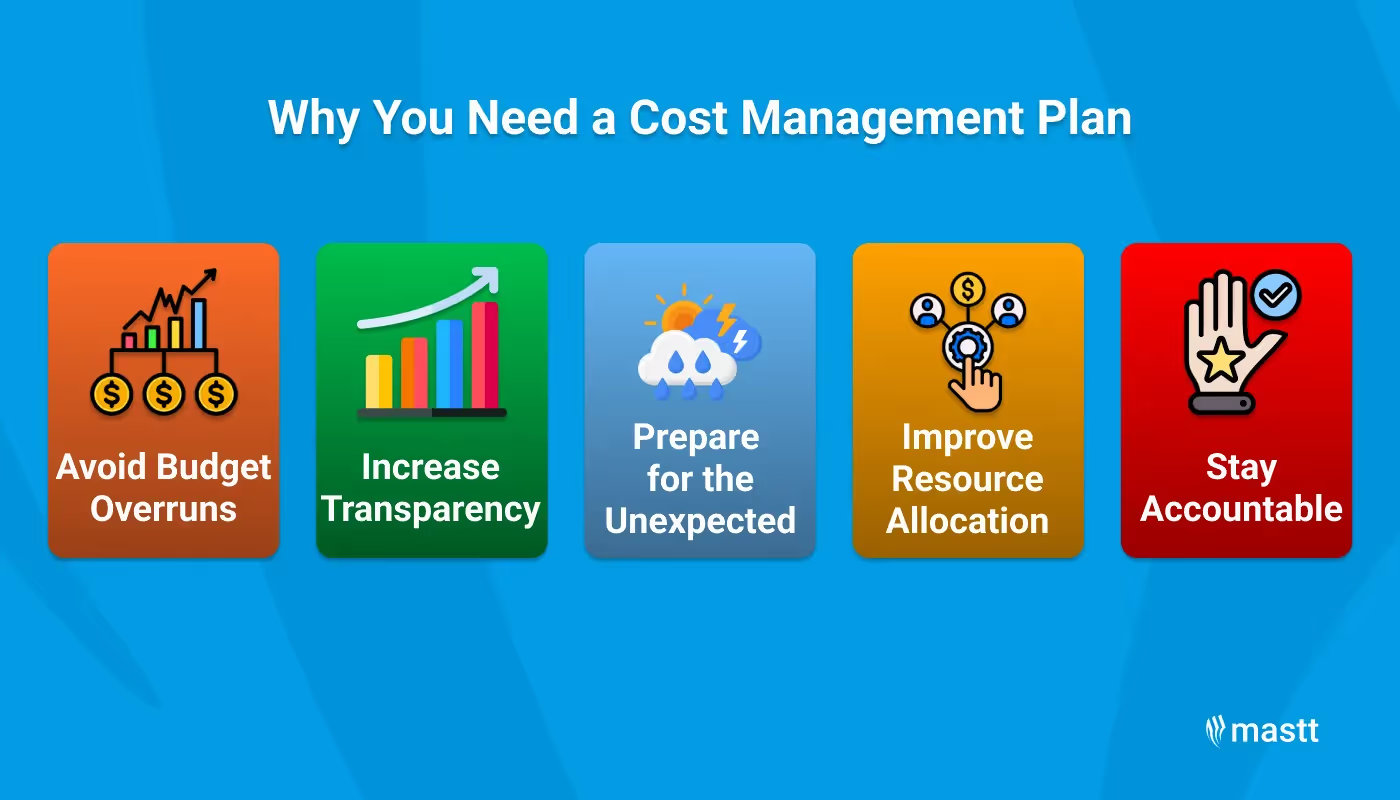Every successful construction project, whether it’s a small residential build or a large-scale infrastructure project, relies heavily on one thing: Cost Management. And at the heart of managing project finances is the Cost Management Plan. But what exactly is a cost management plan, and how can you create one that works for your projects? Let’s dive in.
What is a Cost Management Plan?
A Cost Management Plan is your go-to guide for handling project finances. It’s a clear plan that shows how costs will be estimated, budgeted, tracked, and controlled from start to finish. Think of it as your financial roadmap—it keeps your project on track, within budget, and delivering the quality everyone expects.
Without a good cost management plan, projects can quickly spiral into budget overruns, delays, or worse—total failure. And let’s be honest, no one wants to explain to their team (or their boss) why the budget went off the rails like a runaway train.
Want to learn more about effective budget strategies? Check out our Project Cost Management guide for practical tips.
Key Components of a Cost Management Plan
A solid cost management plan is critical for ensuring your project stays on budget and on track. Here are the essential components to include:
Cost Estimation
Accurately forecasting the costs for labor, materials, equipment, and other project needs is the foundation of a cost management plan. Reliable estimates help prevent unexpected expenses and ensure your budget aligns with project goals. For a deeper dive, check out Construction Cost Estimates.
Budgeting
Once estimates are in place, a detailed project budget is created. This will be the financial baseline that you compare actual project costs against. Need expert tips? Explore What is a Construction Budget.
Cost Control
After your budget is set, the next step is to ensure costs stay within this budget. Cost control methods help to track actual costs and adjust project activities as necessary to avoid budget overruns. Interested in trends? Read about Cost Control Trends.
Change Control Process
Construction projects often face changes (because nothing ever goes exactly to plan). A cost management plan includes a system for reviewing, approving, and controlling changes that impact costs. Check out the importance of tracking changes with this Change Order Template.
Cost Reporting
Regular reporting ensures stakeholders remain informed about the project’s financial status. It helps identify early warning signs of cost overruns, enabling timely adjustments.
Why You Need a Cost Management Plan
A Cost Management Plan isn’t just a document—it’s your safety net for keeping your project financially healthy. It provides clarity and ensures accountability. In addition, helps you avoid the pitfalls of poor financial planning, like unexpected expenses and wasted resources.
Here’s why having a solid cost management plan is a must:
Avoid Budget Overruns
Construction projects often involve fluctuating material costs, labor expenses, and unforeseen site conditions. A well-structured cost management plan helps you track and control spending, preventing your budget from going off the rails.
Increase Transparency
Construction projects involve multiple stakeholders, including contractors, subcontractors, and clients. Clear cost reporting ensures everyone knows where the money is going and why. This transparency builds trust and keeps all parties on the same page.
Prepare for the Unexpected
Weather delays, design changes, and site issues can disrupt even the best-laid plans. A cost management plan helps you handle these surprises by accounting for contingencies and providing a framework for managing unexpected expenses.
Improve Resource Allocation
Allocating resources efficiently is critical in construction. A cost management plan ensures funds are spent wisely on materials, equipment, and labor, reducing waste and improving overall project efficiency.
Stay Accountable
With so many moving parts in construction, accountability is key. A cost management plan holds contractors, suppliers, and project teams responsible for staying within financial parameters and ensures everyone sticks to the financial roadmap.
Without a plan, costs can spiral out of control faster than you can say "budget crisis." Keep your project financially healthy by tracking every dollar and making smart, informed decisions at every stage.

Best Practices for Developing a Cost Management Plan
Creating a cost management plan can feel overwhelming, but following these best practices can set you up for success. Here’s how to approach it with confidence:
Keep Estimates Realistic
It’s tempting to aim low with cost estimates, but that can backfire fast. Be honest and conservative when forecasting costs. This way, you’ll be better prepared for unexpected expenses. Curious about estimation techniques?
Leverage Historical Data
Look at similar projects you’ve worked on in the past. How much did they cost? Adjust for inflation, new market conditions, or unique project details. Past experience is one of the best guides for future planning.
Set Up Regular Cost Reporting
Don’t wait until it’s too late to discover a budget issue. Schedule regular check-ins to compare actual spending against your budget. Early detection of cost overruns lets you adjust before they snowball into bigger problems.
Have a Change Control Process
Changes happen—no project goes perfectly as planned. Having a system to evaluate and approve changes helps you manage costs and avoid chaos when the unexpected strikes.
Use Technology to Your Advantage
Modern software can make cost management easier and more accurate. Tools like Mastt simplify everything from cost estimation to real-time reporting, helping you stay organized and efficient.
Final Thoughts
A Cost Management Plan is crucial for delivering a project on budget and on time. Without one, even the best-laid plans can run off the financial rails. By taking the time to develop a thorough cost management plan, you’ll set yourself up for success and avoid the dreaded budget overrun conversation.
And remember, no one has ever said, “I regret having too much budget control.”
Stay smart with your project finances, and if you need help, you know where to find us!






.avif)






![14 Proven Ways to Reduce Construction Costs [Free Checklist]](https://cdn.prod.website-files.com/607f739c92f9cf647516b37b/67e1f607e284e7835370f1d5_ways-to-reduce-construction-costs.avif)


